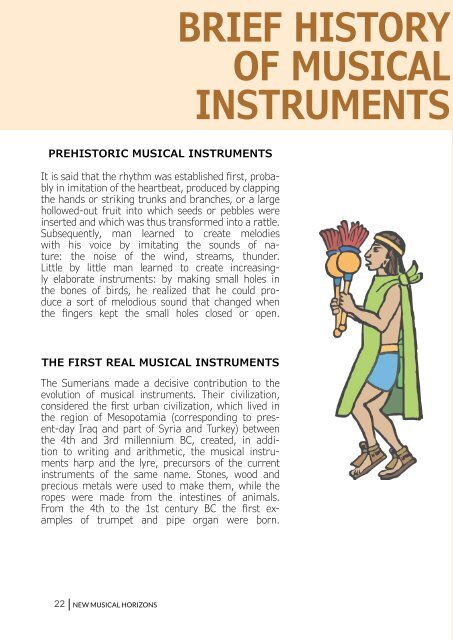NEW MUSICAL HORIZONS, ISSUE 2
What we promise is to give space to strictly independent musicians and composers who want to make their music known to our readers. All topics will be treated in a simple and understandable way. Purely musical themes, history of music, why they say, and curiosities of today and the past will be explored in depth. We trust that what we do and will do is to your satisfaction.
What we promise is to give space to strictly independent musicians and composers who want to make their music known to our readers.
All topics will be treated in a simple and understandable way.
Purely musical themes, history of music, why they say, and curiosities of today and the past will be explored in depth.
We trust that what we do and will do is to your satisfaction.
You also want an ePaper? Increase the reach of your titles
YUMPU automatically turns print PDFs into web optimized ePapers that Google loves.
PREHISTORIC <strong>MUSICAL</strong> INSTRUMENTS<br />
It is said that the rhythm was established first, probably<br />
in imitation of the heartbeat, produced by clapping<br />
the hands or striking trunks and branches, or a large<br />
hollowed-out fruit into which seeds or pebbles were<br />
inserted and which was thus transformed into a rattle.<br />
Subsequently, man learned to create melodies<br />
with his voice by imitating the sounds of nature:<br />
the noise of the wind, streams, thunder.<br />
Little by little man learned to create increasingly<br />
elaborate instruments: by making small holes in<br />
the bones of birds, he realized that he could produce<br />
a sort of melodious sound that changed when<br />
the fingers kept the small holes closed or open.<br />
THE FIRST REAL <strong>MUSICAL</strong> INSTRUMENTS<br />
The Sumerians made a decisive contribution to the<br />
evolution of musical instruments. Their civilization,<br />
considered the first urban civilization, which lived in<br />
the region of Mesopotamia (corresponding to present-day<br />
Iraq and part of Syria and Turkey) between<br />
the 4th and 3rd millennium BC, created, in addition<br />
to writing and arithmetic, the musical instruments<br />
harp and the lyre, precursors of the current<br />
instruments of the same name. Stones, wood and<br />
precious metals were used to make them, while the<br />
ropes were made from the intestines of animals.<br />
From the 4th to the 1st century BC the first examples<br />
of trumpet and pipe organ were born.<br />
BRIEF HISTORY<br />
OF <strong>MUSICAL</strong><br />
INSTRUMENTS<br />
The first musical<br />
instruments used by<br />
man were rudimentary<br />
and came from nature.<br />
Our ancestors, in fact,<br />
used what they found<br />
and had easily<br />
available: animal bones,<br />
trunks and excavated<br />
branches.<br />
And again, drums to get<br />
the rhythm, flutes and<br />
voices to<br />
create melodies.<br />
It therefore seems that<br />
already in prehistory<br />
man dedicated<br />
himself to music,<br />
experimenting with the<br />
very first musical<br />
instruments in the<br />
woods and caves and<br />
creating the first songs<br />
and melodies.<br />
Thanks to the<br />
Sumerians there was an<br />
important<br />
evolution with the<br />
invention of the harp<br />
and the lyre, both<br />
equipped with strings<br />
that were plucked to<br />
produce sounds.<br />
PIANO AND VIOLIN:<br />
THE GREAT CLASSICS<br />
Above all, the piano, invented by Bartolomeo<br />
Cristofori, marked the modern<br />
era. It is an instrument whose strings<br />
are struck by small hammers.<br />
The piano spread in the eighteenth<br />
century, obscuring the scene that until<br />
then had been that of the harpsichord.<br />
At the same time, the violin also began<br />
to become very popular, in particular<br />
those produced by the luthier Stradivari.<br />
Around the mid-nineteenth century<br />
(the period in which the drums and<br />
saxophone also began to spread) the<br />
modern guitar also began to spread.<br />
the fingers kept the small holes closed<br />
or open.<br />
ELECTRICAL AND<br />
ELECTRONIC INSTRUMENTS<br />
Technological advances led to the creation<br />
of completely different musical<br />
instruments. One of the first was the<br />
theremin which is played by moving the<br />
hands in the electromagnetic field that<br />
the device creates; yes, this is probably<br />
the only instrument that can be played<br />
without touching it!<br />
Subsequently electric guitars, synthesizers<br />
and samplers of every type,<br />
shape and price.<br />
Currently in recording studios and almost<br />
everywhere, software that replicates<br />
the sounds of their “brothers”<br />
real synthesizers and samplers are becoming<br />
increasingly popular.<br />
22 <strong>NEW</strong> <strong>MUSICAL</strong> <strong>HORIZONS</strong><br />
CONTINUE 23




